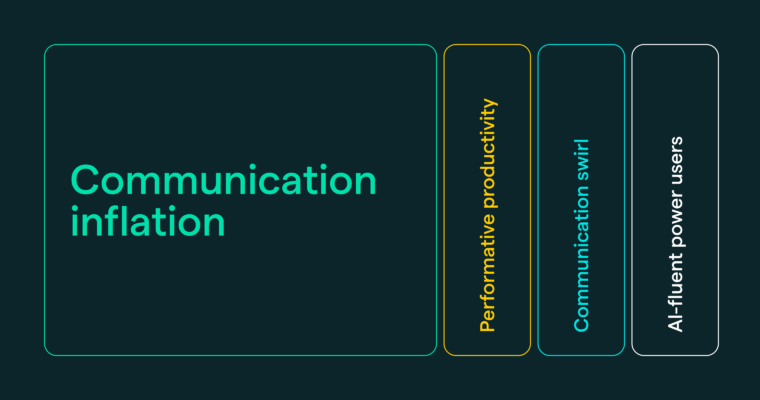By now, business leaders know that having a robust enterprise AI strategy is not just an option; it’s a necessity. Artificial intelligence (AI) offers unprecedented opportunities for innovation, efficiency, and a competitive advantage in today’s market that leaders cannot let pass. However, you’ll only realize the potential of AI if you successfully integrate it throughout your business operations.
The journey to successful enterprise-wide AI adoption can be complex and challenging. To succeed, businesses must develop their enterprise AI strategy so that their workforce knows how to navigate the complexities of AI implementation and usage. In this blog, we’ll discuss the importance of a well-defined AI strategy and offer a roadmap for achieving enterprise-wide AI adoption.
5 Things You Need to Know Before Developing Your AI Strategy
The AI Marketing Institute’s founder and CEO, Paul Roetzer, joined Grammarly’s Engineering Director, Courtney Napoles, in a webinar, “AI Adoption Across the Enterprise: Think Big, Act Small, and Accept Change,” to discuss the five things that every business leader and knowledge worker needs to know before they develop their AI strategy. Here’s what they shared:
- AI awareness and adoption are accelerating. AI has existed for over a decade, but the rise of generative AI has catapulted adoption, particularly in the business world. Grammarly’s 2024 State of Business Communication survey report found that 89% of business leaders and 52% of knowledge workers are using AI regularly.
- Big tech is betting on the future of AI. We’re seeing the advancement of AI from major tech companies, including Microsoft, Google, and OpenAI, as well as from domain experts like Grammarly. These companies are using AI to help people accelerate ideation, strengthen messaging, enhance tone and style of voice, and help everyone communicate more effectively. The tools that we use to do our jobs are getting smarter, so we’re seeing increasing levels of value creation and, therefore, adoption.
- LLMs are powering innovation. Large language models (LLMs) are what tools like ChatGPT and Grammarly run on. Because of how they work, it’s best to think of these tools as assistants or aids to your work, not as replacements. This means that there are many different AI applications, not just predicting your next words. You can use it for ideation, automation, transcription, translation, summarizing, decision-making, and more. It puts the power in the user’s hand, not the AI’s.
- These LLMs are the foundation for what comes next. According to Roetzer, today’s AI is the least capable AI you will ever use. AI will continue to advance and get smarter. This means you will need to continue to sharpen your AI literacy so you can not only keep up with AI but stay ahead so that it is your competitive edge. The next generation of AI is going to be truly intelligent assistants, not only responding to our prompts but also taking action on our behalf to open workers up for more strategic and impactful work.
- AI will impact every knowledge worker. Roetzer predicts that within the next one to two years, at least 80% of what knowledge workers do every day will be AI-assisted. This doesn’t mean their jobs will be replaced; it means that AI will assist with more tasks, allowing workers to work faster, more efficiently, and do more than ever before.
So what do you do with this information? The first step is creating your AI strategy so that you’re prepared to take your business into the future and implement AI across your enterprise.
What Is an Enterprise AI Strategy?
An enterprise AI strategy is your business’s plan to select, implement and utilize AI throughout your organization. It provides guidance on approved tools and AI applications, highlights key areas where AI can drive operational efficiency and innovation, and outlines acceptable use guidelines for employees. Your enterprise AI strategy ensures that your AI initiatives align with your organization’s goals and your enterprise security posture.
Key elements of your enterprise AI strategy
To help you get started on your enterprise AI strategy, we’ve included a list of some of the core components that you should consider adding to your strategy. Think of this as a starting place, not a comprehensive list.
As a first step, your company should put together an AI council that is responsible for creating this strategy and ensuring that it evolves with your business and with AI developments while still putting your human workforce first.
Here are the core components of your enterprise AI strategy:
- A clear vision and objectives: Establish a clear vision and specific objectives for AI initiatives that align with organizational goals. This will allow you to present your objectives to top executives and key stakeholders, secure their support and buy-in, and ensure that AI projects are properly resourced.
- Guidance on AI platforms and systems: Selecting the right AI platform is essential. Your strategy should provide guidance on the types of AI models and tools that support your objectives and are approved for use.
- High-impact AI use cases: Evaluate current workflows to identify and prioritize specific use cases for each team within your organization where AI brings significant value and aligns with your business goals. In addition, you should conduct an AI impact assessment, thinking about how AI will affect different roles and responsibilities throughout your workforce. Now is the time to plan for how AI will change and disrupt your operations.
- Pilot projects and proof of concepts: Outline very specific proof of concept tests with small groups before you commit to full AI deployments. Showcase early wins that you achieve in pilot programs where key individuals or teams experiment with gen AI tools.
- Education and training plans: AI education and upskilling must become a top priority. AI literacy is a foundational skill for every employee to focus on, so your AI strategy should include a plan for tool onboarding, training, and continuous education for your entire workforce.
- A robust data strategy: A robust data strategy is foundational, as AI is data-driven. This involves managing datasets, ensuring data privacy, and setting up data pipelines.
- Integration and deployment owners: To integrate AI tools into your existing business workflows, you should define owners within your IT team who will manage the deployment.
- Privacy and security policies: Prioritize security and privacy by monitoring how your employees use gen AI technologies and watching for risky or unusual inputs and outputs. Security, data privacy, and protection of company intellectual property are top gen AI concerns for over two-thirds of knowledge workers and business leaders. Choose a secure and reputable AI provider to ensure the protection of sensitive company data.
- Acceptable use guidelines: Draft clear usage policies that define acceptable and unacceptable uses of gen AI in your business operations. This will help prevent misuse and provide leadership with peace of mind.
- A statement on ethical considerations: Develop an ethical framework for gen AI that addresses key issues such as data privacy, security, bias, and responsible AI. This framework should align with your brand’s values and compliance requirements, as well as focus on how to maintain a human-centered approach so that the adoption of this technology benefits your employees and customers.
- An AI roadmap: Finally, your AI strategy should include an AI roadmap that includes plans to stay up to date with AI advancements and changes in regulations.
Including these components in your enterprise AI strategy allows you to prepare for the future and set your business up for AI-powered success.
A refresher on generative AI models, machine learning, and LLMs
Before we move on to how you can facilitate org-wide AI adoption, it’s important to remind ourselves of the fundamentals of generative AI. You can’t expect your workforce to effectively utilize new technology without at least a basic knowledge of what it is and how it works.
Generative AI, commonly known as gen AI, is a branch of machine learning (ML) in which algorithms and models are trained on large amounts of raw data to create new outputs, such as text, images, or other content.
Unlike traditional AI, which follows predefined rules, generative AI algorithms use machine learning techniques to learn from existing datasets and generate new, similar content. This capability is powered by advancements in natural language processing (NLP) and machine learning, enabling AI systems like Grammarly and ChatGPT to produce human-like text.
One critical component of your enterprise AI strategy is understanding the large language models (LLMs) that the gen AI technology uses to actually generate text. LLMs are trained on vast amounts of data, which allows them to perform the tasks that we ask them to do. There are many different LLMs that are trained on different data-sets and fine-tuned to perform certain tasks. Some LLMs may be great at natural language processing, which allows them to generate text when asked a question, while others perform better at coding tasks, and others are better suited for translation assistance. ChatGPT, for example, is a chatbot application that uses an LLM to generate text content in various formats.
The foundation of an LLM is its training data and algorithms. This training data could be public text gathered from the internet or it could be proprietary data sources. Both the volume and the quality of the data that each LLM is trained on impact how that LLM will learn. The more high-quality data, the better the LLM becomes at predicting human language patterns, generating contextual and relevant responses, and performing the specific tasks it’s been fine-tuned to perform.
Two (of many) LLM behaviors to be aware of:
- Hallucinations: While receiving a seemingly perfectly crafted answer from AI models may sound ideal, LLMs can create outputs that sound confident and reliable but are actually false or misleading.
- Biases: If an LLM is trained on unreliable data, such as massive amounts of text data from the internet, which is subject to societal biases, it can reflect or amplify existing prejudices found in its training data.
That’s it for your quick refresher. Now let’s dive into how you can successfully implement AI throughout your business operations.
Your Roadmap to Enterprise AI Adoption
Every business is starting at a different place with generative AI adoption. Some may have their AI strategy well-defined, while others are just getting started. Early adopters might be ahead of the curve and the competition now; however, with an emerging technology like gen AI, the curve continues to move. We are all at the beginning of a long-term shift that takes proactive planning, incremental adjusting, and the occasional pivot to achieve true digital transformation and see real results.
That’s why it’s important to assess where your organization is currently in its AI adoption in its AI adoption journey and identify areas for improvement so you can transform your business.
The enterprise AI adoption framework
Understanding where your business is in its enterprise AI adoption journey is key to developing and maturing your AI strategy. This framework should help you understand your current stage of adoption.
- Aware. The first stage is simply being aware of generative AI technology. At this stage, people within your organization have an early interest in gen AI and may be researching different tools to build an understanding of their capabilities and different use cases for your business.
- Experimenting. The second stage is all about experimentation with gen AI tools. In this phase of adoption, AI literacy is likely limited, with only a few select people or teams actively using gen AI in their day-to-day work.
- Optimizing. In the third stage of enterprise AI adoption, businesses are focused on optimization. Graduating from the experimentation phase means applying all of the lessons learned into repeatable processes. You should use that to define a gen AI strategy and implement tools for the majority of your employees to use regularly.
- Standardizing. The fourth stage is focused on ensuring standardized usage of gen AI across the business. This involves investing in proper technology for every team, creating a culture of innovation, and encouraging the appropriate use of AI tools to drive the business forward.
- Transforming. The final stage of enterprise-wide gen AI adoption is when businesses truly transform and gain a competitive edge. At this level, your business is using gen AI to completely transform its operations and employees’ communication.
Download “The New Language of Business: How an AI-Literate Workforce is the New Competitive Advantage,” for a complete guide on how to improve the AI literacy and adoption of your organization.
Overcoming challenges in AI adoption
Having an understanding of where your business currently sits is a solid first step toward business transformation. But it’s what you do with that knowledge that really matters. Enter enterprise AI adoption gaps. These are a few key challenges that companies must overcome to achieve successful AI adoption.
- Stakeholder buy-in: If your business is stuck in the awareness stage, it’s likely that you have a lack of buy-in across the organization to try out gen AI technology. You could be missing key buy-in from leadership, whose approval you need before bringing in new technology. It could also be because the company is stuck in a state of fear of messing up, so they’re avoiding getting started altogether. Or there could be a lack of buy-in from employees who prefer to avoid new technology and use more traditional methods to communicate.
- Skills gaps: The majority of companies today are in the experimentation stage of gen AI adoption. It’s possible that you have a few individuals who use gen AI regularly for communication, but your workforce’s overall AI literacy is holding you back from reaching the next phase. Someone who is literate with gen AI has a fundamental understanding of the tools and their capabilities, is comfortable using them regularly for some communication tasks, and is starting to see personal benefits—but has room to improve to realize its full potential.
- Technology and data privacy: If you find your business stuck in the optimization phase, it’s likely because you don’t have the proper AI tools in place to support each function or the strategies to make the most of those tools. Ensuring data privacy is paramount to AI adoption. You must address security and privacy concerns with every single AI vendor that you consider investing in before making the decision to purchase.
- Ethical concerns and responsible AI: Ethical concerns are critical in AI adoption. Businesses must ensure that the AI models they use are transparent, fair, and unbiased in order for leadership and employees to feel comfortable and confident using the technology. You should develop an ethical framework and responsible usage guidelines as a part of your AI strategy in order to help your workforce overcome this concern.
AI As a Competitive Edge
Embarking on the road to enterprise-wide AI adoption is no small feat—it requires a thoughtful and strategic approach. By developing your enterprise AI strategy, understanding where you are on the path to org-wide deployment, and having a plan to overcome the challenges and gaps to adoption, you can position your organization not only to adapt to the AI-driven future but to thrive with a competitive edge.
Enterprises with a strategic approach to AI are better positioned to innovate by developing and deploying AI-driven products and services in ways that differentiate them from their competitors. AI advancements can also enhance your company’s ability to adapt to market changes, customer preferences, and other technological advancements, further strengthening your competitive edge.
By focusing on key components such as clear objectives, a solid data plan, the right technology and skills, and solid governance, businesses can successfully integrate AI into their operations. For those ready to embark on this journey, our comprehensive framework for safe generative AI implementation provides the guidance needed to navigate the complexities of AI implementation.



